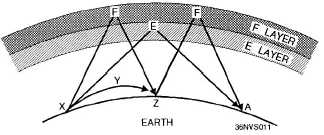density is the greatest. As a radio wave passes into
the ionosphere, it loses some of its energy to the free
electrons and ions present there. Since the amount of
absorption of the radio-wave energy varies with the
density of the ionospheric layers, there is no fixed
relationship between distance and signal strength for
ionospheric propagation. Absorption fading occurs for
a longer period than other types of fading, since
absorption takes place slowly. Under certain
conditions, the absorption of energy is so great that
communication over any distance beyond the line of
sight becomes difficult.
Although fading because of absorption is the
most serious type of fading, fading on the ionospheric
circuits is mainly a result of multipath propagation.
Multipath Fading
MULTIPATH is simply a term used to describe
the multiple paths a radio wave may follow between
transmitter and receiver. Such propagation paths
include the ground wave, ionospheric refraction,
reradiation by the ionospheric layers, reflection from
the earth’s surface or from more than one ionospheric
layer, and so on. Figure 1-11 shows a few of the paths
that a signal can travel between two sites in a typical
circuit. One path, XYZ, is the basic ground wave.
Another path, XFZ, refracts the wave at the F layer
and passes it on to the receiver at point Z. At point Z,
the received signal is a combination of the ground
wave and the sky wave. These two signals, having
traveled different paths, arrive at point Z at different
times. Thus, the arriving waves may or may not be in
phase with each other. A similar situation may result
at point A. Another path, XFZFA, results from a
greater angle of incidence and two refractions from
the F layer. A wave traveling that path and one
traveling the XEA path may or may not arrive at
point A in phase. Radio waves that are received in
phase reinforce each other and produce a stronger
signal at the receiving site, while those that are
received out of phase produce a weak or fading
signal. Small alterations in the transmission path
may change the phase relationship of the two signals,
causing periodic fading.
Figure 1-11.—Multipath transmission.
Multipath fading may be minimized by practices
called SPACE DIVERSITY and FREQUENCY
DIVERSITY In space diversity, two or more receiving
antennas are spaced some distance apart. Fading
does not occur simultaneously at both antennas.
Therefore, enough output is almost always available
from one of the antennas to provide a useful signal.
In frequency diversity, two transmitters and two
receivers are used, each pair tuned to a different
frequency, with the same information being
transmitted simultaneously over both frequencies.
One of the two receivers will almost always produce a
useful signal.
Selective Fading
Fading resulting from multipath propagation
varies with frequency since each frequency arrives at
the
receiving point via a different radio path. When a
wide
band
of
frequencies
is
transmitted
simultaneously,
each frequency will vary in the amount of fading.
This variation is called SELECTIVE FADING. When
selective fading occurs, all frequencies of the
transmitted signal do not retain their original phases
and relative amplitudes. This fading causes severe
distortion of the signal and limits the total signal
transmitted.
Frequency shifts and distance changes because
of daily variations of the different ionospheric layers
are summarized in table 1-1.
1-9


